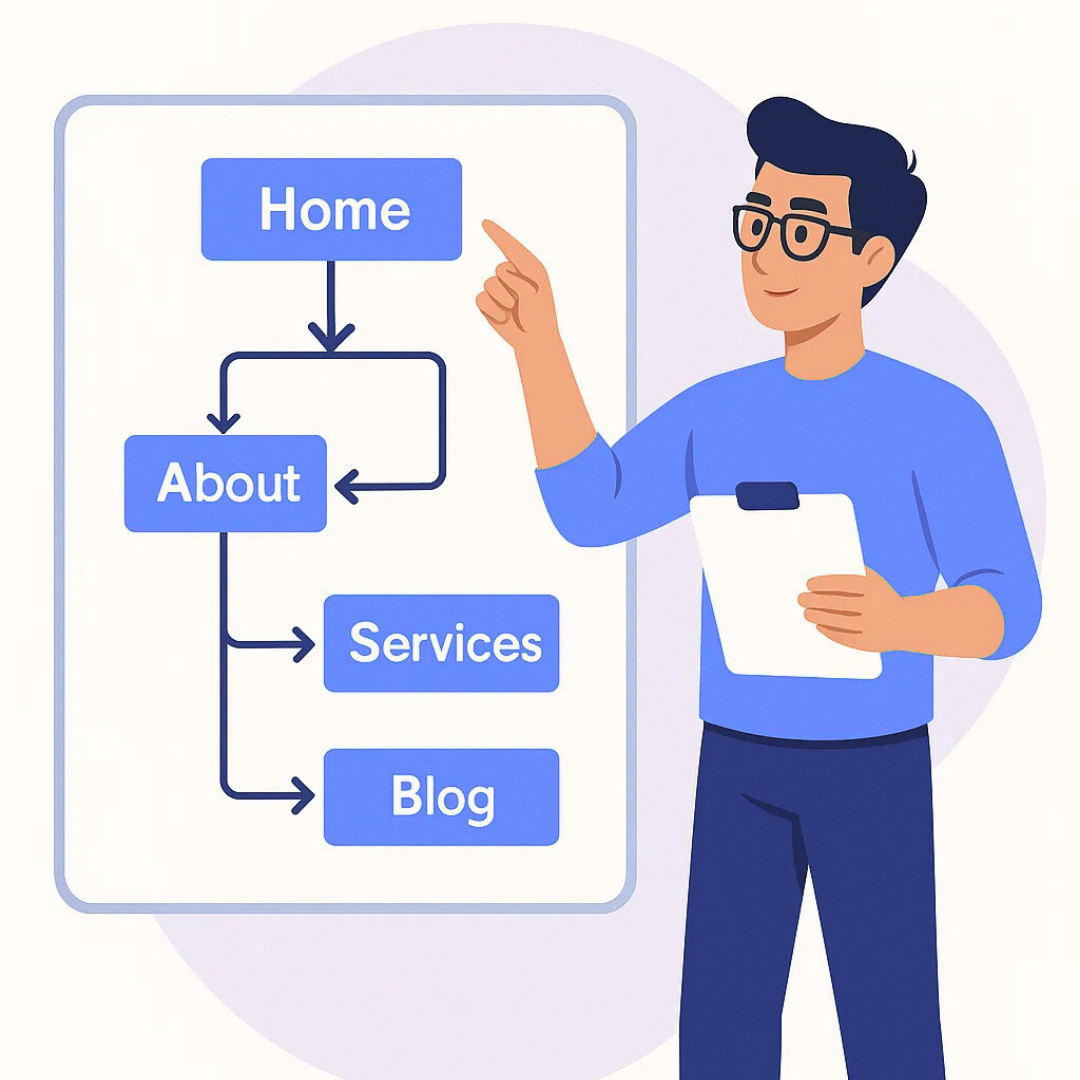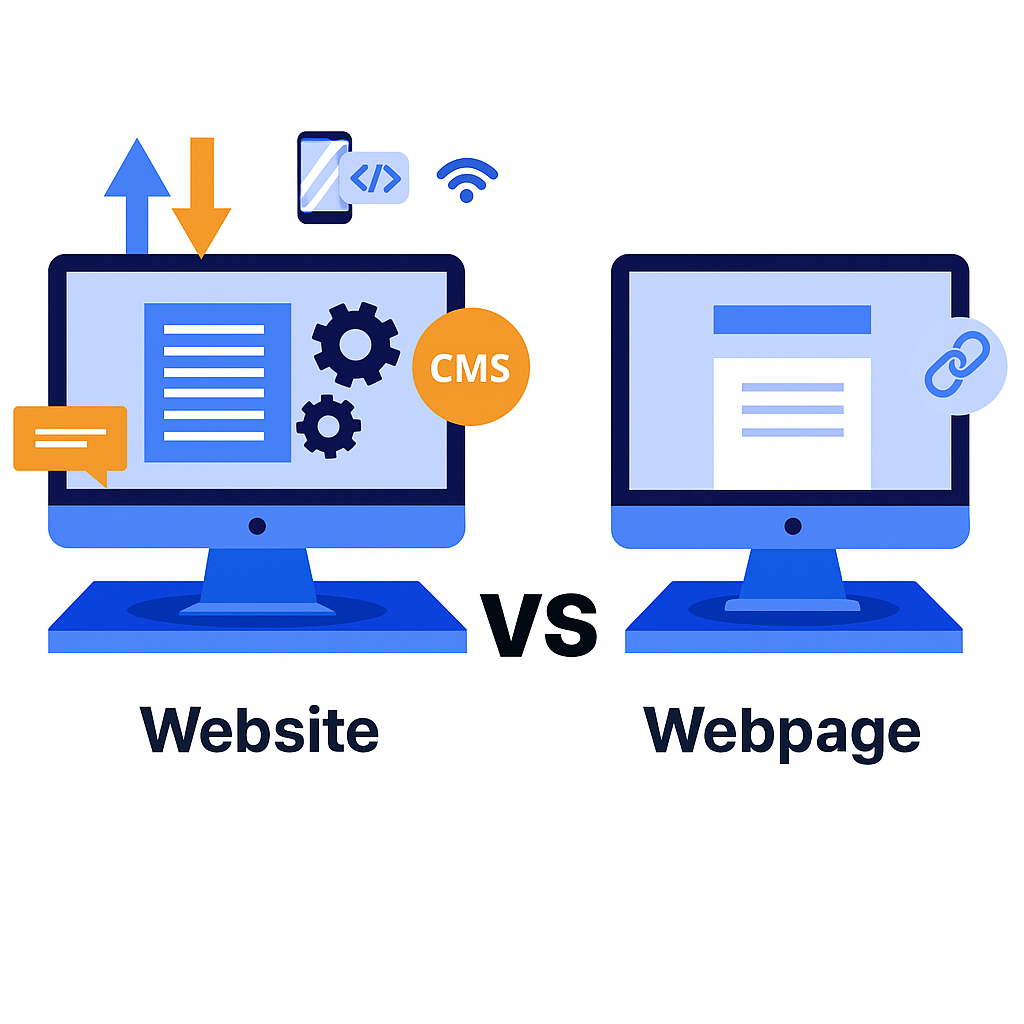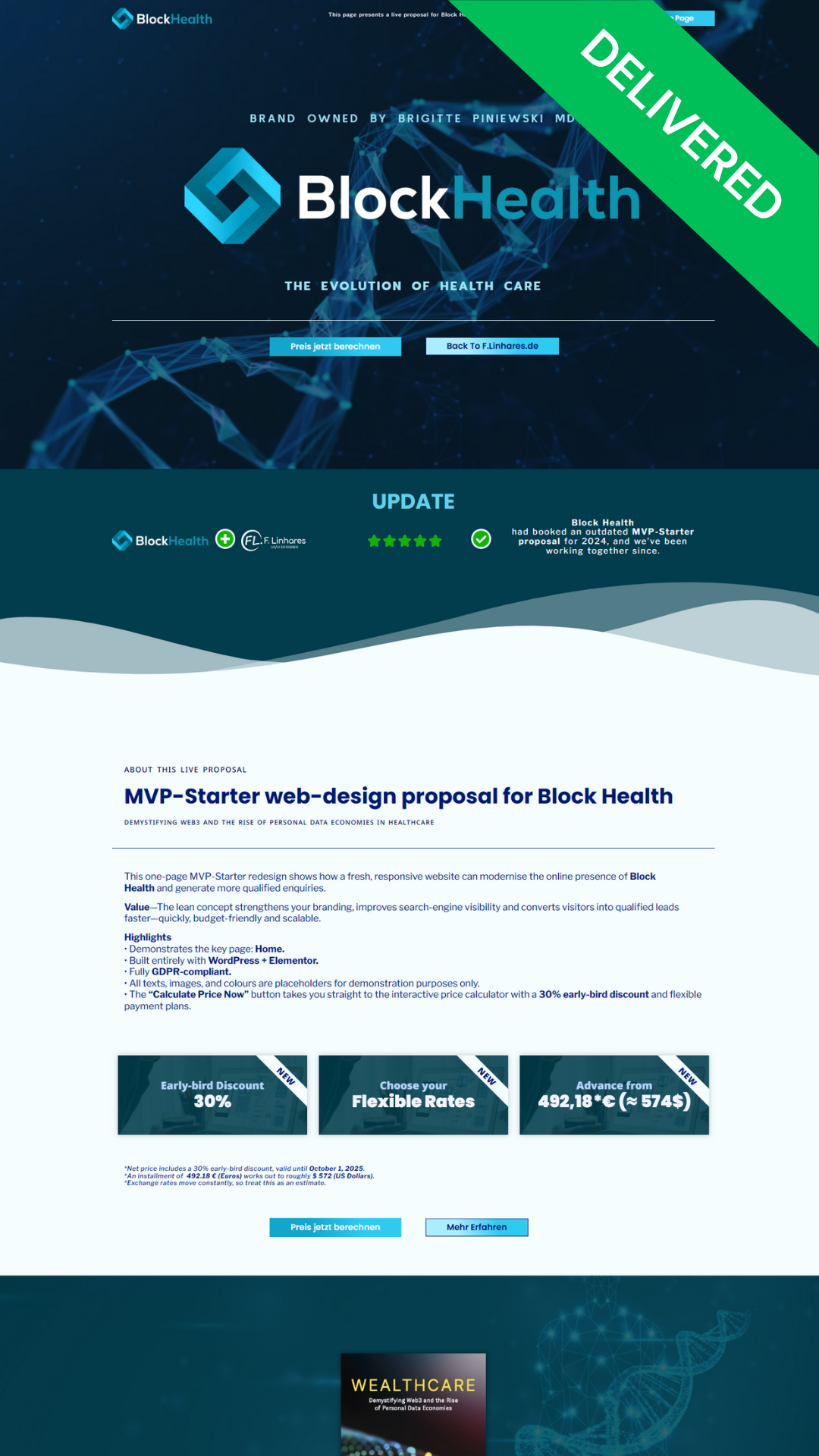- Founder’s Playbook
Building Smart: Website Structures for Startups
In this post you will learn:
- Website ≠ Webpage: A website is your whole domain; a webpage is one screen within it. Plan the site, then design the pages.
- Choose a structure that fits your goal:
- Linear: step-by-step flows (onboarding, checkout, funnels).
- Tree/Hierarchical: most startups; scalable categories and subpages.
- Webbed/Matrix: heavy interlinking (wikis, knowledge bases).
- Database-driven: dynamic, large catalogs (e-commerce, listings, UGC).
- Hybrid: mix patterns for complex products.
- Why MVP websites: Launch the smallest valuable site to test the offer, get real data, cut cost/risk, and iterate fast.
- MVP essentials: Clear value prop, one primary action, fast performance, analytics, feedback loop, privacy basics.
- Build sequence: Define user → pick structure → map 4–6 pages (Home, Offer/Services, Pricing, FAQ, Contact, 404) → wireframe → ship → measure → iterate.
- My 3 MVP packages (why this split):
- MVP-Blog: content-first validation (authority & SEO).
- MVP-Starter: service-led lead gen (pricing/booking ready).
- MVP-Portfolio: proof-of-work with case grids.
Fixed structures = faster builds, lower costs, easier upgrades.
Why structure matters when every euro counts
Your digital shopfront is often the first and only chance you have to make an impression when you start a business today.
A lot of founders, though, see a website as just a bunch of pages instead of the ecosystem it really is. How those pages are linked together affects how easy it is for users to navigate, how quickly Google indexes your content, and how quickly you can make changes as your idea grows.
This guide, written from the perspective of another entrepreneur, will clear up the confusion between a website and a webpage, go over the main types of site architecture (linear, tree, webbed, database-driven, and hybrid), and show you how a minimum viable product (MVP) approach can help you get your business off the ground faster and smarter.
We’ll also talk about new UX/UI trends that will shape 2026 and why I offer three fixed-scope MVP packages for new businesses.

Website vs. webpage — the foundation of your understanding
Let’s clear up some terms before we get into architecture.
A website is the place where all of your online content is stored, including all of your pages, posts, files, and databases that are related to your product or brand.
A webpage is just one file in that website. This difference isn’t picky; it changes how you plan, budget, and build.
A website is like a book, and a webpage is like a single page or chapter in that book.
The homepage of the site is like a table of contents. It links to the most important parts and helps users find their way around. The homepage has links to the main pages, like About or Services. These pages lead to subpages that have more information on specific topics.
In the past, guides often strictly defined structures as home page, main pages, and subpages. But now, platforms let you connect in a more fluid or dynamic way.
If you’re a startup working on an MVP, knowing what makes up a “page” can help you avoid building too much. You don’t have to put all of your ideas on one big site. Instead, you can launch with a focused landing page and a few subpages that answer basic questions like:
- “Who are you?”
- What issue do you help with?
- How can visitors get involved?
This small scope cuts costs and lets you test your ideas quickly. You can add more pages to the site structure as your business and audience grow.
That is the reason why F. Linhares created structured basic MVP-Bundles: MVP-Blog with 8 pages, MVP-Starter with 10 pages, and MVP-Portfolio with 12 pages.
Knowing these words also makes it easier to talk to designers and developers.
A one-pager is a kind of website that has only one page. Websites can also have different types of pages, such as home pages, landing pages, product pages, and contact pages, each of which serves a different purpose for the user. Using clear language stops scope creep and surprise costs.
Why planning your site structure matters

Your site’s structure is more than just how it looks; it’s the plan that shows how information will flow.
A well-organised structure not only makes it easier for users to find their way around, but it also makes it easier for search engines to index content, which helps SEO.
If people can’t quickly find what they’re looking for, they’ll leave and probably go to a competitor’s site.
A clear hierarchy, on the other hand, helps search engines figure out how pages are related to each other and rank them correctly. Good structures also make maintenance easier because you know where new topics go and you can change content without breaking links.
From a startup’s point of view, a well-thought-out structure is a way to get more done. When you don’t have a lot of time or money, a logical layout lets you write each piece of content once and link it well instead of repeating information on different pages. A smart hierarchy also makes it possible for the site to grow in the future.
You can add new categories or subpages without having to change the whole site, which saves money and lowers technical debt. A clear site map is important because it makes it easier for visitors to go deeper into your funnel, like from a landing page to pricing to a contact form. This increases conversion rates.
Linear (sequential) structures — guiding users step by step
The linear or sequential structure is the easiest type of site architecture. The pages are all lined up in a single path. Like reading a book or taking an online course, users start at the beginning and go through a set order. According to Octopus.do, linear structures work best for small, goal-oriented websites where you want to lead visitors through a set process, like onboarding flows, checkout pages, or training modules. You can get rid of distractions and make it more likely that you will do what you want by limiting your options.
They are still useful today, but only when you have a clear goal and a clear path to get there. A startup could use a linear mini-site to test one specific value proposition.
Consider a landing page that leads directly to a sign-up form, followed by a thank-you page.
This structure becomes less effective when more content is added, as it can disrupt the flow and make it difficult to follow. Users can’t look into other topics because there’s only one way to get around the site, which makes cross-selling and discovery harder.
Hierarchical (tree) structures — the default for growing sites
The most common way to organise things on the internet is in a hierarchy or tree. It looks like an organisational chart, with the homepage at the top and linking to category pages, which then link to subpages.
Each node can have more than one child, which means that there can be more than one user journey. Hierarchical structures are great for businesses that offer a lot of different products or services because they are so flexible. Apple and Microsoft are two examples of companies that use this model because it lets users go straight to different parts of the site, like “Products,” “Support,” or “Company.” Hierarchical structures work for both small sites with less than ten pages and big online stores with hundreds of items.
A hierarchical approach gives startups a clear way to grow.
You can start with a homepage and a few main categories, like “About,” “Services,” and “Blog.” Later, you can add subpages for things like case studies or product details without changing the main layout. The downside is that it gets more complicated; as your site grows, navigation needs to stay simple. This is where breadcrumbs and internal linking come in handy.
They help people find their way around and get back to higher-level sections. The tree won’t get tangled if you plan ahead and use the same names all the time.

Webbed (matrix) structures — connecting everything

A webbed or matrix structure means that most pages are linked to each other, which makes a network instead of a strict hierarchy. Wikipedia is the best example. Each article can link to dozens of others, so people can easily move between topics. This design encourages exploration and keeps users interested by giving them many ways to get in and out. But there is a price to pay for the freedom: it can be hard to keep track of link architecture and keep users from getting lost. Webbed structures need a lot of internal linking and upkeep.
A matrix structure might work for startups if your MVP is based on curated content or sharing knowledge, like an industry wiki or a resource library. It can also be helpful when your audience needs to be able to get to any part of your content from any other part. For example, think of a SaaS documentation site where every article links to other related topics. But be careful: if your site grows quickly, linking without structure can make things less clear and confuse visitors. To keep things manageable, you’ll need a good internal search function and clear navigation cues.
Hybrid structures — mixing and matching
In reality, not many websites follow just one pattern. A hybrid structure is made up of parts from linear, hierarchical, webbed, or database-driven models. A hybrid site usually starts with a hierarchical structure and adds linear flows (like a checkout process) or matrix components (like related articles) as needed. For example, an e-commerce site might use a tree structure to group products into categories, but a linear sequence for the purchase flow and a webbed network of related product recommendations to get people to buy more than one thing. You can customise the user journey to fit the situation with hybrid structures.
For new businesses, hybrid designs are often the best choice. Start with a simple hierarchy for your main content. Then, add a linear funnel for important actions like signing up or buying something, and finally, add contextual links to useful resources. The most important thing is to avoid complexity creep. Mixing structures should help you reach your goals, not make things harder. Use analytics to find out how people move around and make changes as needed. You can also try things out with hybrids; for example, you can A/B test different flows without having to rebuild the whole site. Ultimately, the best structure is the one that fits with your product, your audience, and your resources.
Choosing the right structure for your MVP
Choosing a structure isn’t just about following the rules; it’s about meeting your business goals and serving your audience. You should think about what your business needs, like if you need to sell things, get leads, or teach people. You should also think about your target audience:
What do they need to know and how do they like to get it?
Do they want a quick, linear experience or the ability to explore widely?
The type of content is also important. For example, a proof of concept may only need a simple landing page, while large catalogues need hierarchical or database structures.
Startups should ask themselves, “What is the main thing we want users to do?“
A linear or small hierarchical site is usually enough for your MVP if its goal is to get people to sign up for emails or test a single feature. You can move to a hybrid or dynamic structure as you add more features and content. Keep in mind that every extra layer adds to the cost of design and development. If you plan ahead, you can build a structure that allows for growth without having to completely change it later. Write down your decisions in a site map, and then look at the plan again as your product changes.
Introducing MVP websites — lean, fast and focused

The term “minimum viable product” (MVP) comes from lean startup methodology and means launching the simplest version of a product that can prove your value proposition. An MVP website is a simple but useful site that has only the most important features needed to solve a main user problem and get feedback.
You build an MVP site quickly to test your ideas, lower the risk, and get real user data. You put usability and value ahead of perfection.
What steps should a startup take to develop its MVP while considering these trends?
Begin by booking the services of F. Linhares, UX/UI Designer, and together we will determine the main user journey that you need to test. Then pick the fewest number of web pages that will help with that journey (MVP-Starter, MVP-Blog or MVP-Portfolio)
Why is this important for new businesses?
CB Insights says that 35% of startups fail because there isn’t a need for their product. You could waste money by making a nice website without first testing your idea.
You can launch your site sooner, get feedback, and make changes with an MVP site.
The goal is to see if users are interested in what you have to offer and to find out what features they really want. The MVP does its job as long as it works and clearly explains your main value proposition.
Why I offer three MVP packages — blog, starter and portfolio
Based on what I’ve seen, a lot of startups have trouble figuring out what their first site should look like. I have three set packages:
MVP-Blog, MVP-Starter, and MVP-Portfolio.
This makes the choice easier and keeps costs predictable. Each package comes with a set of pages that are organised in a way that is similar to the simple diagrams you saw before.
The MVP-Blog has about eight pages, including the main legal pages (home, legal notice, privacy policy, contact, and 404), an About page, and a blog with one post. This is ideal for founders who want to share their story and publish content regularly.
The MVP-Starter (about ten pages) adds a Services page and a Business page to the Blog package. It’s made for new businesses that offer professional services and need a little more room to explain what they do.
The MVP-Portfolio, which is about twelve pages long, has a portfolio section with multiple project pages instead of a blog. This is great for freelancers or creative agencies that need to show off their work.
The number of pages is not random; by limiting the number of pages, I can keep the project manageable and get high-quality, custom designs to you quickly and for less money. Because the structure is already set, development can go more smoothly, which cuts down on setup time and makes pricing clear. You can always add more to these packages once your MVP is working.



